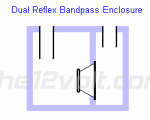I've been considering building my first band pass enclosure and after modelling with winisd here is what i came up with for an Alpine swr12d2.
Opinions on the frequency response are welcome. Also i'm a bit confused, wimisd has the box listed as a 6th order bandpass but their diagram looks more like Dual Reflex bandpass. Does anyone know which it is actually modelling?
Opinions on the frequency response are welcome. Also i'm a bit confused, wimisd has the box listed as a 6th order bandpass but their diagram looks more like Dual Reflex bandpass. Does anyone know which it is actually modelling?












